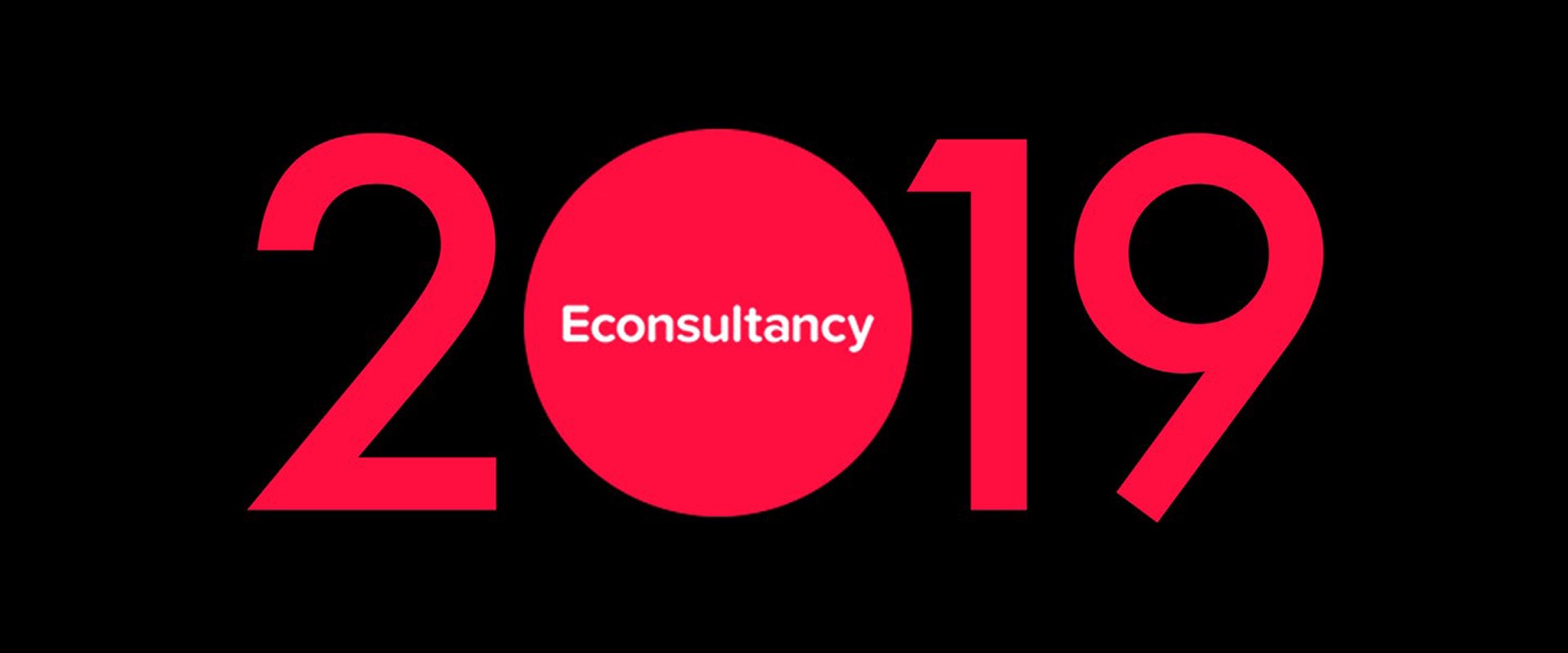Econsultancy are the leading independent digital marketing trade body. They carry out and provide extensive research, analysis and data around digital, marketing and e-commerce. They’ve been around since 1999 as a digital community for marketers and, as longstanding members, we often tap into their expertise, resources and experience. This blog post is an edit of the most relevant highlights from their 2019 digital trends and predictions piece, and it includes lots of acronyms!
1. Cx - Customer Experience
Customer experience is still the priority, but this is as much a mindset as a discipline and it should form the bigger part of what marketers should spend their time focusing on. We'll be posting an in-depth blog on Customer Centricity in the next few days, but the hot areas for 2019 are real-time experiences, mobile and personalisation. Key to achieving the best possible experience, across all touchpoints, is effective Ux and design.
2. Content Marketing
The focus on content marketing is still key and it will continue to mature in 2019 with key trends being:
Quality content. There's been a tendency to ‘pump out’ content with too much emphasis on quantity rather than quality. There is little value in mediocre quality content created for its own sake, it is better to take more effort on doing less content but making it better to have a chance of creating impact.
Content distribution. Again, there has also been a tendency to spend too much time on creating content and too little time promoting and distributing that content properly. We now know that perhaps 50% of resource needs to be spent on distribution and promotion to get the most value out of the content.
3. Video
The importance of video will continue to be a focus for content over 2019 as its popularity grows. Formats to suit the medium and platform are important - portrait versions are more viewed than landscape on mobile. As with all content marketing storytelling is a great approach and is even more effective with video and it may need captioning for when audio is not available. Live streaming will continue to grow in 2019.
4. Mobile
'Mobile first' has been the mantra in B2C for some time and John Lewis’s 'How we shop, live and look' report revealed: “2018 was the year of shopping on the move as mobile overtook desktop and tablet as the most convenient way for people to browse and shop. Shoppers still like to make bigger, more considered purchases via desktop but it is clear that mobile is catching up in this area, with 21% of sales made on the move, up 16% from this time last year.”
A recent Deloitte mobile consumer survey in the US found that:
- Smartphones were used by 85% and are the most favoured mobile device among US consumers.
- Americans are viewing their smartphones on average 52 times per day.
- Tablets had the largest year-over-year decline idecreasing from 62% to 57%.
- Over 80% of consumers are concerned about sharing, use, and storage of personal data.
- Only 31% of consumers used mobile in-store payments.
- Smartphone voice assistants remain very popular with 64% of consumers using them compared to 53% in 2017.
The importance of speed in the customer experience and in SEO has been mentioned already, but data from Google last year showed that for 70% of the mobile landing pages they analysed 'it took more than five seconds for the visual content above the fold to display on the screen, and it took more than seven seconds to fully load all visual content above and below the fold.' As can be seen from the subsequent analysis of bounce rates in the graphic below. Most businesses are therefore failing when it comes to speed on mobile which dramatically increases the bounce rate.
We've blogged before about Accelerated Mobile Pages before and we expect to see implementation increase in 2019 to improve the customer experience and SEO. ASDA recently published data: 'using AMPs led to a 1.71 times faster site speed and a 32% improvement in click-through rate from organic mobile traffic. This is significant considering 65% of Asda’s visitors are on a smartphone.'
5. E-commerce
The economic climate for most retailers has been tough over last year and it's even affected online retailers most notably with ASOS reporting lower than expected sales. The focus for 2019 for most e-commerce retailers is likely to be on efficiency, optimisation, experience and improving conversion rates or lowering return rates. For example:
- ‘Try before you buy’ options for customers are likely to increase e.g. clothes retailers also sending a size higher/lower than ordered and the delivery person waits whilst the customer tries on the clothes.
- Experiments like Waitrose’s delivery service trial which allowed their drivers to enter your home when you are out so that they can put your food shopping away for you.
- Pay-later financing options, enabled by the likes of Affirm or Paypal Credit, offering zero down payment for products like electronics, clothes and home goods.
Whilst levels of innovation for most e-commerce players may be more restricted than previously, there will be further innovations in the connected home [IOT], voice and mobile.
6. SEO - Search Engine Optimisation
The focus for SEO should be on:
- Conversational content including questions and answers and the phrases people would say rather than keywords.
- Reviews and ratings.
- Video.
- Site links.
- Featured snippets [which relates to conversational content].
- Site speed - Google are using page speed as a ranking factor in mobile search results.
- Use of data signals.
Google’s launch of Google Marketing Platform, and the closer integration of their various advertising products with their data and optimisation tools (like Google Analytics, AB Testing, Data Studio) is significant.
7. Paid media and advertising
The growth in digital advertising spend is not in question with a 23.1% increase in digital ad spend year on yea and 2019 is expected to be the first time ever that people around the world will spend more time online than they do watching TV. The broader trend continues to be how best to combine the various media, tactically we can expect the following over 2019:
- Native and video advertising.
- Ecommerce advertising – such as Easyjet's campaign allowing customers to click through a destination photograph to booking.
- Instagram growth – particularly around its Stories format. Merkle’s recent digital marketing report found that Instagram spend grew four times faster than Facebook and YouTube advertisers spend tripled in 2018.
8. Social Media
Facebook is static or declining but Facebook-owned Instagram and WhatsApp are growing strongly. Snapchat is growing and not just for younger users. And now, of course, there is TikTok exploding onto the scene. There are plenty of new formats and opportunities in 2019:
- WhatsApp - Facebook’s “Click-to-WhatsApp ads” ads that launch a WhatsApp chat via the Facebook News Feed. WhatsApp Business App announced a year ago, this is currently a free-to-download Android app for small businesses allowing them to create business profiles and have a messaging relationship with customers. WhatsApp will show ads in the app’s status feature this year but there are no specific timings yet.
- Instagram - it’s not a new feature but Polls in their Stories are an interesting way for brands to get customer insight. IGTV announced last June, Instagram call this “the next generation of video” and is for watching longer-form, vertical video i.e. for mobile where most video viewing now happens.
- Messaging - Apple Business Chat is due this year and, along with Facebook Messenger and WhatsApp Business App, it will see brands experimenting this year with a new medium for customer interaction.
- Influencer Marketing -2019 will be the year influencer marketing evolves as the amounts of money being spent grow, so media agencies will need to treat influencer marketing more strategically and not just as an extension of a short-term, tactical PR campaign. New software will emerge to addres the flake influence problem.
- B2B Social Media - it may be damaging for LinkedIn’s level of engagement and value in the long term, but in the short term there is no sign that LinkedIn’s growth is slowing or that their advertising solutions and opportunities are decreasing. Twitter may have had its challenges but is also growing and both will remain important for B2B marketing in social over 2019. Messaging also presents an exciting opportunity in B2B.
9. Email and marketing automation
It's not the sexiest or hottest topic but, despite the new GDPR regulations, email is still the workhorse of digital marketing. It's still about personalisation, integration across the customer journey, mobile optimisation and responsive design across all devices. 2019 is more of the same for email, but email is very much at the heart of much bigger challenges around marketing logic, data orchestration and experience architecture.
10. Data and Analytics
The world of digital has been talking about data-driven marketing for a long time, but increasingly data needs to be the starting point for your business. And, as with customer experience, this is as much about strategy, culture, talent and process as it is about technology or any specific discipline. 2019 will see the following focus areas for data and analytics:
- Data security – data breaches will inevitably continue but there's a growing emphasis on board level accountability.
- Data privacy – GDPR is merely the beginning of an era where marketers, and customers, are going to think much more carefully about their data.
- Data integration – integrating online/offline data to understand customers across channels, ongoing efforts to create dashboard reporting and analysis which shows consolidated views.
- New forms/sources of data – e.g. streamed realtime data.
- Machine learning – to better turn data into insights and actions.
For 2019, digital marketing is looking at being more responsive, authentic and analytical, as we embrace new media, platforms and opportunities. At bd2 we work closely we our clients to identify the most appropriate marketing channels, supporting them as required. As always, we’ll be keeping an eye on these trends, and reporting on any developments over the year.

